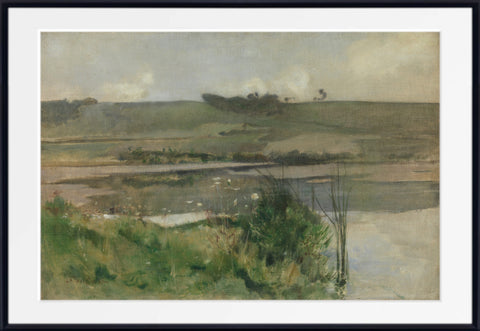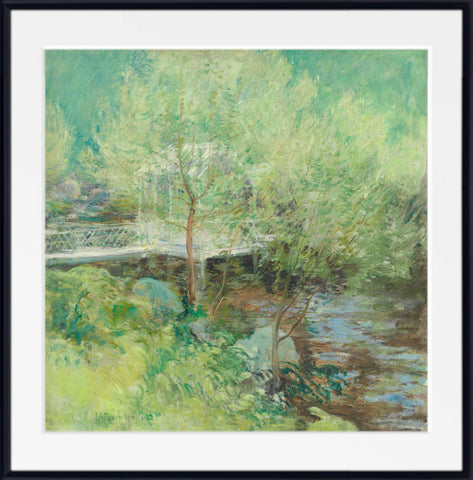Table of Contents:[hide]
Introduction
John Henry Twachtman, born on August 4, 1853, in Cincinnati, Ohio, left an indelible mark on the American art scene as a prominent Impressionist painter. Renowned for his distinctive approach to landscapes, Twachtman's artistic journey reflects the evolution of American Impressionism. This article explores his life, artistic contributions, and enduring legacy.
Early Life and Education
Twachtman's artistic journey began with his early exposure to the world of creativity. Born to German immigrants Frederick Christian and Sophia Droege Twachtman, he demonstrated a passion for art from a young age. In 1875, he ventured to Munich, Germany, to study painting, where he adopted the broad brushwork and warm, dark coloring characteristic of the Munich school. His early canvases bore the influence of the Munich Academy.
Parisian Influence and Impressionist Beginnings
In 1883, Twachtman relocated to Paris, a pivotal move that exposed him to the revolutionary art movement of Impressionism. Enrolling at the Académie Julian, he immersed himself in the vibrant Parisian art scene and encountered the works of prominent Impressionist painters. This period marked a significant shift in Twachtman's artistic style, as he began experimenting with broken dabs of color, a hallmark of Impressionist techniques.
The Formation of The Ten
Twachtman's artistic pursuits led him to become a founding member of The Ten, a group of American painters who sought to break away from traditional artistic norms. The Ten exhibited together, advocating for artistic independence and pushing the boundaries of conventional art. This period marked the beginning of Twachtman's emergence as a leading figure in American Impressionism.
Greenwich Years: Maturity and Innovation
From 1890 to 1899, Twachtman lived in Greenwich, Connecticut, where he reached artistic maturity. This period of his life was marked by innovation and experimentation. His landscapes from this time reflect a fusion of his earlier Impressionist influences and a more personal, progressive style. Twachtman's paintings during his Greenwich years are celebrated for their poetic and progressive qualities.
Notable Works
1. Arques-la-Bataille (1885)
One of Twachtman's celebrated works, "Arques-la-Bataille," showcases his mastery in capturing landscapes with a distinctive Impressionist touch. The painting is recognized for its progressive and poetic representation, highlighting Twachtman's departure from traditional landscape depictions.
2. The White Bridge (1897)
"The White Bridge" exemplifies Twachtman's ability to convey the beauty of the American landscape through the lens of Impressionism. The painting reflects his evolving style and his keen sense of capturing light and atmosphere, a hallmark of the Impressionist movement.
3. Horseneck Falls (1900)
A later work, "Horseneck Falls," reveals Twachtman's continued exploration of the landscape genre. The painting demonstrates his commitment to pushing artistic boundaries, employing a more experimental approach that distinguishes him as a progressive figure within the American art scene.
Legacy and Influence
Twachtman's legacy endures as one of the pioneering figures in American Impressionism. His contributions to The Ten and his innovative approach to landscape painting have left an indelible mark on the trajectory of American art. Today, Twachtman's works are celebrated for their progressive qualities and their role in shaping the narrative of American Impressionism.
Frequently Asked Questions (FAQs)
-
Q: What is John Henry Twachtman best known for?
- A: John Henry Twachtman is best known for his contributions to American Impressionism, particularly his distinctive approach to landscape painting.
-
Q: Where was Twachtman born and raised?
- A: Twachtman was born on August 4, 1853, in Cincinnati, Ohio, and spent his formative years there.
-
Q: What was the significance of Twachtman's time in Munich?
- A: Twachtman went to Munich in 1875 to study painting, adopting the broad brushwork and warm coloring of the Munich school, which influenced his early canvases.
-
Q: How did Twachtman's relocation to Paris influence his art?
- A: In Paris, Twachtman encountered Impressionism, leading to a shift in his artistic style. He began incorporating broken dabs of color, a hallmark of Impressionist techniques.
-
Q: What is The Ten, and what was Twachtman's role in it?
- A: The Ten was a group of American painters advocating for artistic independence. Twachtman was a founding member, and their exhibitions played a significant role in challenging traditional artistic norms.
-
Q: What are some of Twachtman's notable works?
- A: Some notable works include "Arques-la-Bataille" (1885), "The White Bridge" (1897), and "Horseneck Falls" (1900), showcasing his mastery in capturing landscapes with an Impressionist touch.
-
Q: Where did Twachtman reach artistic maturity?
- A: Twachtman reached artistic maturity during his years in Greenwich, Connecticut, from 1890 to 1899, marked by innovation and experimentation.
-
Q: What is Twachtman's lasting legacy in American art?
- A: Twachtman is remembered as a pioneering figure in American Impressionism, leaving a lasting legacy through his contributions to The Ten and his progressive approach to landscape painting.
In conclusion, John Henry Twachtman's journey from Cincinnati to the vibrant art scenes of Munich and Paris, his role in The Ten, and his innovative Greenwich years have solidified his place in the annals of American art history. His legacy continues to inspire artists and admirers alike, reminding us of the enduring impact of American Impressionism.
Prints and Canvas Panels
Related Articles
American Impressionism





